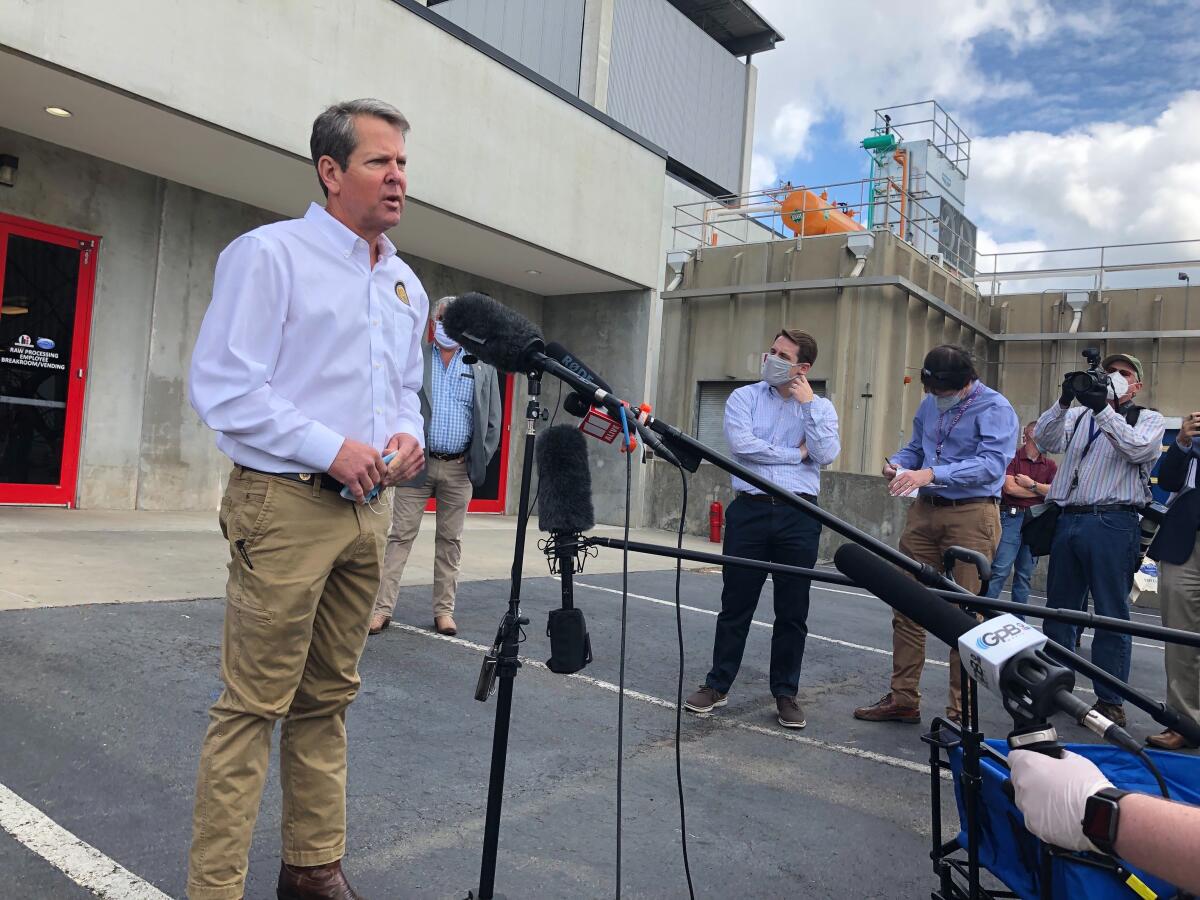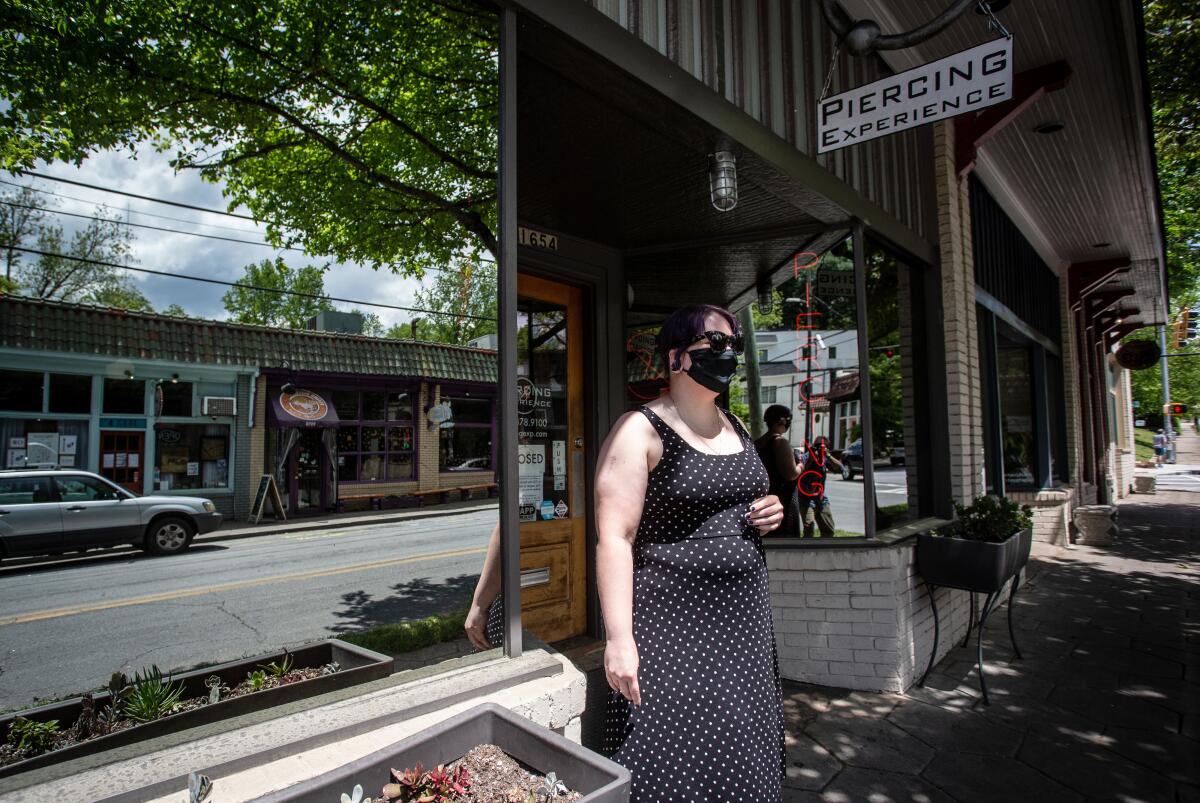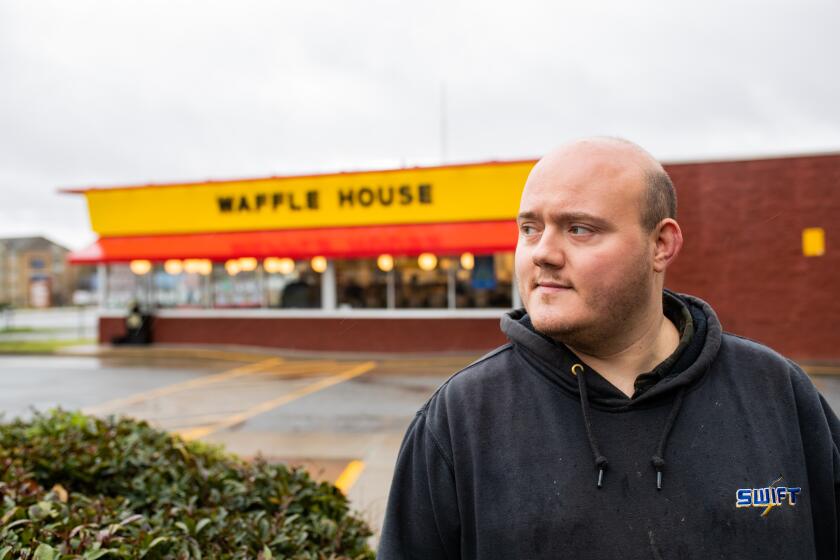Georgia reopened first. What the data show is a matter of fierce debate

- Share via
ATLANTA — Nearly a month after Georgia became the first state to allow businesses to reopen after the coronavirus shutdown, Gov. Brian Kemp took to a conservative radio show to tout some good news.
Hospitalizations were down more than 30% in less than three weeks, and Georgia had ramped up its testing, with a per capita rate that placed it 20th out of 54 U.S. states and territories, up from 46th a month ago, he explained.
“We’ve got to keep our foot on the gas,” the Republican said this week on pundit Erick Erickson’s WSB-AM drive-time show. “What we’re doing is working.”
The next day, one of Kemp’s key facts was thrown into question.
The Columbus Ledger-Enquirer reported that unlike many other states, Georgia calculates its total number of tests by combining viral diagnostic checks, which indicate current infection, and antibody tests, which indicate past infection.
Worse, the state uses this combined total as the denominator when it calculates the percentage of positive diagnostic tests, making that figure look smaller than it is.
“It’s incredibly frustrating,” said Harry J. Heiman, a professor at Georgia State University’s School of Public Health. “The one thing that we’re relying on is transparent and accurate data. So, when that gets undermined, and in the case of Georgia repeatedly undermined, it makes it very challenging to understand what’s going on.”
When Georgia began to allow hair and nail salons, gyms and tattoo parlors to open their doors, some critics predicted that cases, hospitalizations and deaths would surge.
That has not happened, but public health experts said it is still too early to measure the effect of reopening.
And so the debate has devolved into a partisan war over math. Those who want to kick-start the economy tend to be Republicans who focus on the drop in hospitalizations and rise in testing, while those who are more cautious are often Democrats who accuse the state of manipulating the numbers.
Georgia becomes the first state to release guidelines for film and TV sets to reduce the risk of spreading COVID-19. No open calls and, for craft services: prepackaged, individual portions only.
The doubters have found plenty of ammunition on the state Department of Public Health’s website.
Georgia has drawn nationwide ridicule in recent days since it was discovered that a graph on the site presented days out of chronological order — after April 30, it hopped to May 6 and then back to May 4 — creating the mistaken impression that new infections in five hard-hit counties were swiftly declining. Actually, they had plateaued.
Kemp’s office said it was an innocent error, but critics viewed it as part of a pattern of massaging data for political purposes.
Last month, around the time that Kemp began to lift business restrictions across the state, the Department of Public Health changed the way it recorded new cases, listing the date a patient first reported symptoms instead of the date a test came back positive.
The change altered the timeline, shifting cases further into the past.
Critics said the latest controversy — over combining diagnostic and antibody tests — was even more damaging.
The presentation of the data led many Georgians to mistakenly think the state was making faster progress on increasing diagnostic testing and reducing the rate of positive tests.
Since early April, when the website began lumping together both kinds of tests, antibody tests have accounted for about 13% of the total, based on information provided by the health department.
Not counting them drops Georgia’s national per capita ranking from 20th to 29th, the Atlanta Journal-Constitution found.
“Right now, a lot of people are saying, ‘What the hell is going on?’” said T.J. Muehleman, founder of the COVID Mapping Project, an online tool that analyzes COVID-19 data sources. “How do we trust the data?”
Right now, a lot of people are saying, ‘What the hell is going on?’ How do we trust the data?
— T.J. Muehleman, founder of the COVID Mapping Project
At a news conference Thursday, Kemp urged Georgians to be patient and have confidence in the data. He said that staff members were working at “breakneck speed” to compile massive amounts of information and that some of the mishaps were probably due to mounting pressure to swiftly update the state’s website.
“Look, we’re not perfect,” he said. “We’ve made mistakes and, when we do that, we’ll own that, change it and make sure people are aware of that.”
The feud over numbers takes place amid a broader political and cultural divide on risk.
While public health experts worry that relaxing restrictions could cause the virus to rebound, lockdown critics accuse them of focusing on worst-case scenarios. Watching the economic devastation wrought by the virus, they bristle at national media stories that castigate Georgia for leading the race to become “America’s No. 1 Death Destination” and offering its citizens as an “experiment in human sacrifice.”
One Wall Street Journal piece, retweeted by Kemp, hailed the “Georgia model.” The state’s “encouraging escape from lockdown,” it argued, could counter the “horrendous costs of overreaction” and “inspire people to resume necessary activities.”
Yet in a poll conducted in late April and early May, Kemp’s COVID-response ranked the least popular in the nation, with only 39% of Georgia residents saying they approved.
Joey Camp, a Waffle House line cook, was the first person in Georgia to be isolated in a special quarantine site after receiving a diagnosis of coronavirus. Now that he’s out, he can’t understand the big deal.
When Georgia began to reopen April 24, more than 22,000 people in the state had tested positive for the virus and about 890 people had died. Four weeks later, more than 41,000 Georgians have tested positive and more than 1,800 have died.
Tracking the spread of the virus is difficult because there are significant lags between infection, testing, diagnosis, hospitalization and death.
There are also delays as public health officials gather and present information. Data from the last 14 days are typically incomplete, Muehleman said.
For the first few weeks after reopening, experts would expect hospitalizations and deaths to plateau or decline, reflecting the results of sheltering in place. Even after that, widespread hesitation to immediately venture out could prevent a major rise in infections.
In Georgia, many business owners across Atlanta and in towns hit hard by the coronavirus kept their doors shut after Kemp lifted restrictions and many consumers continued to hunker down.

Four weeks on, reopening does not seem to have led to a significant rebound of the economy. The state’s unemployment rate climbed this week to nearly 12% — higher than during the Great Recession.
Still, President Trump has not hesitated to single out Georgia for praise.
“The states are opening up. Numbers are going down as they open,” he said Tuesday at the U.S. Capitol. “Look at Georgia.”
He also praised Florida, where the government has faced accusations that it too is manipulating data to bolster the case for reopening.
This week, Rebekah Jones, a manager of Florida’s COVID-19 website, told West Palm Beach CBS affiliate WPEC-TV that she was removed from her position because she disobeyed orders to “manually change data to drum up support for the plan to reopen.”
At a news conference Wednesday, Gov. Ron DeSantis said that the state’s COVID-19 website was fully transparent and that Jones was dismissed because she put data on the website that “the scientists didn’t think was valid” and refused to listen to her superiors.
DeSantis, a Republican, was quick to dismiss media coverage of his handling of the response as “typical partisan narrative.”
“You’ve got a lot of people in your profession who waxed poetically for weeks and weeks about how Florida was going to be just like New York,” he said. “‘Wait two weeks, Florida’s going to be next. Just like Italy, wait two weeks.’ Well, hell, we’re eight weeks away from that, and it hasn’t happened.”
In Georgia, Erickson, the radio talk show host, mocked critics who focused on the state’s data errors as conspiracy theorists, comparing them to those on the right who once said that COVID-19 was no different than the common flu.
“We’ve gone from COVID-19 truthers on the right to COVID-19 truthers on the left,” he said.
Erickson then offered up a conspiracy theory of his own.
“The reason,” he said, “is because they don’t want the economy to reopen.”
Those who oppose lifting the restrictions argue that Georgia has been spared from a dramatic rise in COVID-19 cases only because so many people ignored the governor.
In Albany, a predominantly black southwest Georgia town ravaged early on by the virus, Demetrius Young, a city commissioner, said he was thankful that the community — including local business owners — had rallied together and continued to shelter in place.
Still, after isolating himself at home for months, Young went to the grocery store last week for the first time.
He planned to host a virtual high school graduation and family brunch for his teenage daughter on Saturday. It wouldn’t be the usual indoor gathering, he said, where everyone piles on top of one another around a table piled high with barbecue and fixings.
Instead, 20 people will gather in his front yard, with households seated a round tables spaced six feet apart, dining on bacon, eggs, grits and salmon croquettes. Everyone would wear masks.
“I won’t even say it’s getting back to normal,” he said. “It’s about moving forward knowing we have to take precautions.”
Sign up for Essential California
The most important California stories and recommendations in your inbox every morning.
You may occasionally receive promotional content from the Los Angeles Times.









